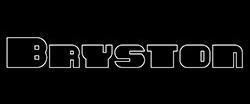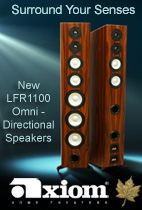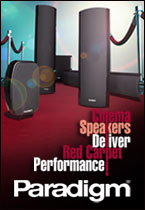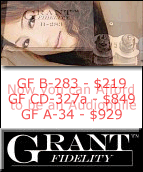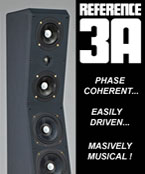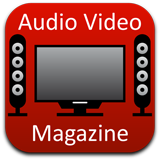
Surround Sound Decoding - so what is everyone talking about? Learn the whole story on the competing formats of surround sound, a little history of each, and which one is best for you.
First off, surround sound is just what the title implies: sound coming from speakers that surround you.
Basically, it refers to the use of multiple audio tracks to envelop the audience in the music or movie, making them feel like they’re in the middle of the action or concert. A surround sound movie soundtrack allows the listeners to hear sounds coming from all around them, and plays a large part in realizing what moviemakers call “suspended disbelief”. “Suspended disbelief” is when the audience is completely captivated by the movie experience and is no longer aware of their real-world surroundings.
To effectively employ the surround sound format, several speakers are needed. The first is a centre speake that carries most of the dialog - since actors usually speak from on-screen positions; next there are left and right speakers that carry most of the music and sound effects, and some of the dialog - when actors speak from a certain angle or side. There is also a pair of speakers that are placed to the side and slightly above the seating area, to provide ambient and surround sound effects. Finally, a subwoofer is often used to create the low and very low frequency effects (known as LFE) that come with certain movie situations (the foot-stomping in Jurassic Park, or the roar of the jets in Top Gun, for instance).
One more important point is that all these speakers have either discrete channels, which means that there is a dedicated signal only for that speaker, or matrixed channels, which are derived - or split - from one or more discrete channels.
This is an important point to understand because the numbers (2.0, 4.0, 5.1, etc.) that accompany surround sound formats are associated with this point. The first number indicates the number of discrete, or independent, channels, that all have a full frequency range (20Hz to 20,000 Hz); so a 2.0 would have two channels, and therefore be stereo, while 5.0 would have 5 separate channels and so would carry independent signals to each of the five speakers in your surround sound set-up. The .1 refers to the LFE (Low Frequency Effect) device, or subwoofer, that only covers the lower frequency range (3Hz to 120Hz). So a 5.1 format would have separate, individual channels for the center, left front, right front, surround left, surround right, and subwoofer speakers.
Dolby Pro Logic
Dolby Pro Logic began appearing in home theatre systems in the early 90′s, and became the standard for Hi-Fi VHS, and is still today’s standard for analog (cable) TV broadcasts, because the Pro-Logic signal can be encoded in a stereo analog signal, which also lets you record to your VCR.
If you do have a Pro-Logic set-up, you can still enjoy DVDs, since all DVD players can down-mix the Dolby Digital information contained on the disc to the Dolby Pro-Logic format, and a stereo (two-channel) output.
Pro Logic is the cheapest and simplest set-up, consisting of 4 channels that are compressed into two analog channels. There are 2 discrete and 2 matrixed channels: 2 discrete, full-bandwidth channels for the left front and right front speakers (L and R); 1 matrixed full-bandwidth channel for the centre speaker (C); and 1 matrixed, limited-width channel that goes to the 2 surround speakers (S). The Dolby Pro Logic encoder takes the 4 channels and creates two output channels - Lt and Rt. L goes to Lt and R goes to Rt without modification; C, after a slight noise reduction, gets divided equally between Lt and Rt. The bandwidth of S gets limited to the 100Hz - 7,000 Hz range, is encoded with a form of noise reduction, and then gets divided between Lt and Rt but with a slight phase shift. So Pro Logic is a 2.0 set-up.
The disadvantages of Pro Logic are that both surround speakers (left and right) produce the same sound from the same channel (mono sound) and have less bandwidth, and the centre speaker is a combination of the other two and not unique. Also, there is no discrete subwoofer channel specified in the standard, so the subwoofer signal is extracted from other channels rather than having its own input.
Dolby has also come out with Pro Logic II, an updated version of the original Pro Logic, which can accommodate 6 channels of output. However, it is not a true 5.1 surround sound system, because it still uses the two stereo channels of Pro Logic, but has an advanced decoder that extracts 5 matrixed full frequency channels and 1 matrixed LFE channel.
Dolby Digital
Dolby Digital is the most common format for surround sound, and has not only becomethe industry standard by which DVDs are produced, but is also part of the High Definition TV (HDTV) standard and is used in pay-per-view movies and digital TV channels - like the DIRECTV system. The successor to Pro Logic, it is present in nearly all movie theatres and began appearing in home theatres in the mid-90′s.
With Dolby Digital you add accuracy and flexibility to your surround sound system because of six dedicated channels, one for each speaker. Dolby Digital provides up to five discrete (independent) channels with a full frequency range (centre, front left, front right, surround left, and surround right), as well as a sixth channel dedicated to LFE, which is usually used for a subwoofer. Because of these five discrete channels, and the one LFE channel, Dolby Digital is referred to as 5.1. Of course, not all Dolby Digital soundtracks have 5.1 channels of audio; some may have less, but this format can support up to 5.1 channels (tracks that do have 5.1 will say so - others may say 2.0, 5.0, etc.)
To compress the data with only a slight loss in sound quality, a process known as “perceptual coding” is used, which attempts to decipher what sounds humans would hear the most, the least, etc.
Advantages over Dolby Pro Logic include the fact that all channels are digital and discrete, and 5 of them are full-bandwidth, as well as the surround speakers using separate left and right channels (stereo). Also, the vast majority of DVD titles are produced in this format, and it is the most common type of home theatre standard.
DTS
An alternative and competing format to Dolby Digital is Digital Theatre System’s Digital Surround - DTS for short. Like Dolby Digital, DTS also uses a 6 channel format, which is also a 5.1 set-up, offering independent channels for each speaker. The main difference between the two is that DTS actually uses less data compression, and so offers higher data rates, which leads most experts to say that DTS offers marginally better sound quality.
DTS is available in select movie theatres, and also appears sometimes as an optional soundtrack on a few DVD titles, but is not nearly as common as the Dolby Digital standard on DVDs. DTS is also not used in HDTV or digital TV broadcasting. However, while Dolby Digital is mainly for DVDs, DTS is being used more and more in the mixing and production of musical performances (CDs), and many CD-only players come equipped with DTS outputs for use with DTS receivers.
DTS does however, have the only 6.1 format [see below]. In addition, DTS also has a format called DTS 96/24: high quality sound playback from ordinary DVD recordings is limited to only two channels and there are also limitations on the picture. DVDs recorded in DTS 96/24, however, allow high-quality 5.1-channel sound playback in full-quality, full-motion video.
THX
THX is not a home theatre surround sound format - well, not exactly. THX is more for movie theatres; for home use, there is only THX Surround EX, which is just like the Dolby Digital EX, but must be mixed by a THX-certified studio, meeting the stringent THX requirements, before being put onto a DVD.
Extended Surround Formats
So you think you know it all now, eh? Well, just to throw you a curve ball, there are also several newer “Extended Surround” formats: THX Surround EX (THX-EX), Dolby Digital EX, and DTS Extended Surround (DTS-ES). So just when you thought that a 5.1 channel system was enough, here we have some more cookies for the jar.
THX-EX and Dolby Digital EX are the exact same formats, developed jointly by THX (Lucasfilm) and Dolby. They are the home theatre versions of the Dolby Digital Surround EX format found in state-of-the-art movie theatres (so from here on in, we’ll refer to THX-EX, because the two are interchangeable).
THX-EX is an extended surround sound version of the Dolby Digital 5.1 format, with DTS-ES being the extension of DTS 5.1. The difference between the 5.1 formats and the extended ones is the addition of a surround back channel, with the speaker placed behind the audience. This lets the home theatre achieve more of a 360° surround sound effect than that of a 5.1 set-up which has no rear speaker. Also, although the EX/ES format supports one rear speaker, two surround back speakers are usually recommended for better sound reception. In order to accommodate this, certain high-end receivers are capable of carrying 7.1 channels.
However, the EX/ES formats are not true 6.1 or 7.1 formats. The surround left and surround right channels carry an additional signal for the surround rear speaker, which is extracted from these two channels, and then sent to the surround rear speaker. So because the rear speaker has a matrixed channel, and not a discrete channel, these formats are not true 6.1 systems. This is why these formats are often referred to as THX-EX 5.1, or DTS-ES 5.1 (or DTS-ES Matrix).
Only one format, the DTS-ES Discrete 6.1, has a true 6.1 format, with an independent channel for the surround rear speaker. Again, this sound is better realized with two rear speakers, and the 7.1 receivers come in handy in this case. There is also a newer format, DTS neo:6 Surround, which is a format between the DTS-ES Matrix and DTS-ES Discrete. This format applies conventional 2-channel signals to the digital matrix decoder used for DTS-ES Matrix to achieve a 6.1-channel surround sound playback. This enables full band reproduction (frequencies of 20 Hz to 20,000 Hz) for all 6.1 channels, and separation between the different channels is improved to the same level as that of a digital discrete system.All Extended Surround formats are completely backwards compatible with their 5.1-channel counterparts. That is, THX-EX is backwards compatible with Dolby Digital 5.1, and DTS-ES Matrix and DTS-ES Discrete 6.1 are backwards compatible with each other, and with DTS 5.1. In order to hear the Extended Surround formats, you will need a THX Surround EX, DTS-ES Matrix, or a generic “6.1-channel” decoder in your receiver or preamplifier, and to hear DTS-ES Discrete 6.1, you will need a DTS-ES Discrete 6.1 decoder in your receiver or preamplifier.
Only certain newer DVDs have the optional support for these extended surround formats. However, those that do, take full advantage of the increased speaker capacity and offer an improved listening and home theatre experience.
Finally!
Now we get to the big question: Which one actually sounds better? Well, there are fierce supporters of both standards (Dolby Digital/THX and DTS), and some contend that it may even depend on the setup of your home theatre or sound system. In the end you will have to judge for yourself, and see what you think is better, although for most people the two are indistinguishable.
But whatever format you choose to go with - Dolby Digital, DTS, or one of the extended ones - you will definitely need five or six channels of amplification, and one or two extra speakers for the surround back channel, as well as the 5 main speakers for your set-up. Most receivers nowadays have support for all of these formats, but to easily check, simply look on the front of the receiver: the name and logo of the supported formats will appear on the face of the receiver. And don’t worry about your DVD player - you can still use your existing (or a soon-to-be-purchased) DVD player, in conjunction with your receiver that supports these formats. So get out there and start watching movies! (Of course, it is a nice day out…)
Click here to discuss this article on the CANADA HiFi Forum

